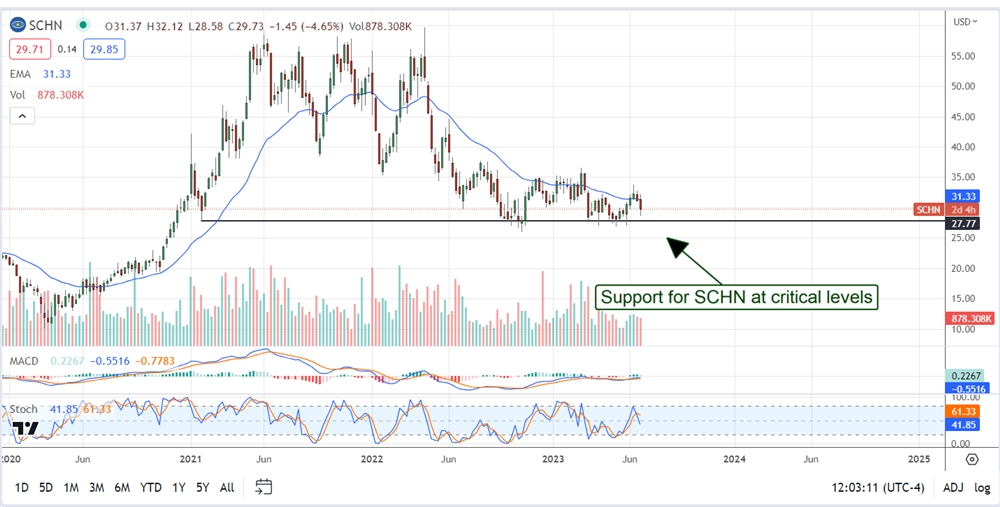Schnitzer Steel’s NASDAQ: SCHN Q3 results echoed those of Commercial Metals Company NYSE: CMC but the impact on the stock price was the opposite. The report's takeaways are that industry normalization has revenue and earnings down compared to last year, but signs of normalization and underlying market strength have emerged.
Both companies noted significant sequential improvement in operating dynamics centered on demand and pricing. Pricing is still down compared to last year but up significantly compared to the previous quarter as demand rises YOY.
Demand is due to secular trends, including a resilient new home market, the shift to electrification and green technology, and government-related spending spurred by the Inflation Reduction Act and the Infrastructure Investment and Jobs Act.
Schnitzer Steel Has Solid Quarter Despite Headwinds
Schnitzer Steel had a solid quarter in FQ3 despite the macroeconomic headwinds reported in other sectors. The company reported $810 million in net revenue, down nearly 20% compared to last year, and missed the consensus by 150 basis points. The mitigating factor is that pricing is 100% to blame, and the company can not control the market price for metals.
The salient factor is that results improved sequentially, driven by demand in all segments. Volume increased sequentially and YOY in all segments and was offset by a price decline that hit the bottom last quarter. Assuming underlying trends remain the same, the company should return to growth in FQ1 or CQ3 2023.
The margin news is similarly mixed, with the margin down significantly compared to last year but up sequentially. The gross margin improved by 220 basis points, and SG&A was steady as a percentage of revenue, leaving the GAAP and adjusted earnings better than the Marketbeat.com consensus predicted.
The adjusted $0.67 is down more than 75% from last year’s bubble-induced highs but $0.03 better than expected and more than 4 times better than the previous quarters. The company did not give any guidance, but apparent sequential momentum suggests normalization in the industry. Assuming the strength continues, the Q4 results will be down less than 10% compared to last year and the last quarter of contraction.
Schnitzer Steel Dividend: How Safe Is It?
Schnitzer Steel raised a red flag when it reported negative cash flow for the quarter. That is mitigated by an increase in working capital and timing of payments that more than offset the difference. The takeaway is that cash flow remains robust enough to pay the debt and dividends.
The dividend is worth about 2.45% to investors and is less than 25% of earnings. The company has not increased distribution since 2012 but could at this level.
The analysts may have given up on Schnitzer Steel, but the institutions haven’t. There is only 1 analyst with a rating less than a year old, and that 1 is from mid-2022. It rates the stock at Buy with a price target about 30% above the current action. On the other hand, institutions own about 80% of the company and have been buying on balance. The institutions bought on balance the last 3 consecutive quarters and have helped to put a bottom in the market.
The Technical Outlook: Schnitzer Steel Is At Bottom
The price action in Schnitzer Steel is tepid following the Q3 results, but the market bottom is in. The stock may continue consolidating at this level, not move higher, but lower prices are not expected either. Critical resistance will be at the 150-day moving average and the top of the recent trading range near $35. A break above that level would be bullish.

Before you consider Radius Recycling, you'll want to hear this.
MarketBeat keeps track of Wall Street's top-rated and best performing research analysts and the stocks they recommend to their clients on a daily basis. MarketBeat has identified the five stocks that top analysts are quietly whispering to their clients to buy now before the broader market catches on... and Radius Recycling wasn't on the list.
While Radius Recycling currently has a Hold rating among analysts, top-rated analysts believe these five stocks are better buys.
View The Five Stocks Here
MarketBeat just released its list of 10 cheap stocks that have been overlooked by the market and may be seriously undervalued. Enter your email address and below to see which companies made the list.
Get This Free Report
Like this article? Share it with a colleague.
Link copied to clipboard.